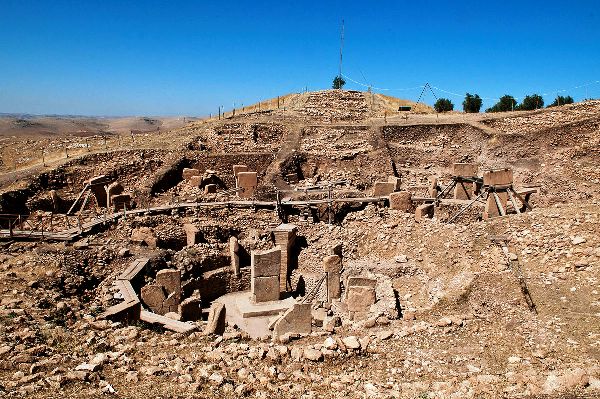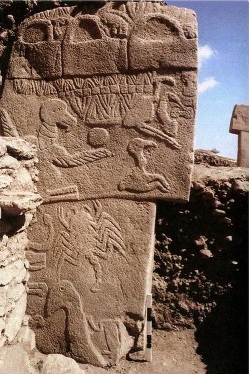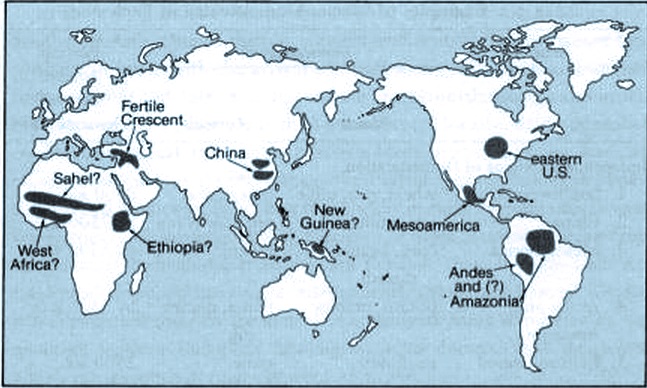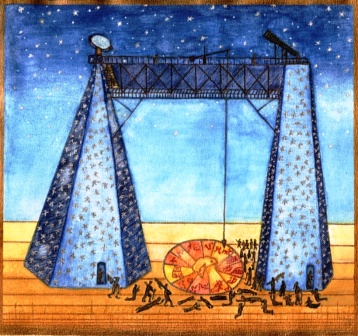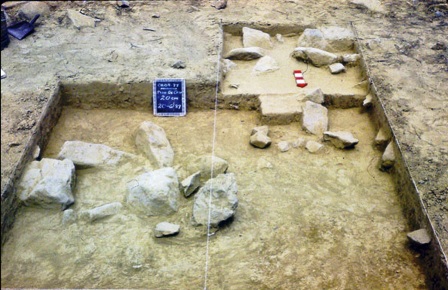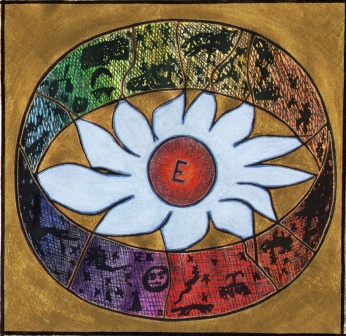Oahspe Study
First Agriculture and Religion
|
|
|
Gobekli Tepe - Oldest known religious structure constructed circa 12,000 years ago |
The beginnings of Agriculture and Religion have been constantly been pushed further back in time as new archaeological discoveries unearth evidence that shows the arts and practices of agriculture, religion and other forms of civilization existed long before all mortal historical records. However, as much as he digs and relies on being informed by buried "treasure" man will not have a complete or true picture until he learns to look up instead of down. For it was by and through man's spiritual nature that he came to learn and practice civilization, and that thread goes back to his beginnings as a species. Ergo, the beginnings of agriculture and civilization go back much further than man's latest discoveries which have pushed back the dates of the first agriculture to 12,000 years ago.
But, according to many Flood Stories from around the World , the knowledge of food cultivation had been thriving long before and was preserved by survivors of the flood and passed on to their descendants. The truth behind the origins of these flood stories is confirmed by Oahspe's account of the sinking of the great Pacific continent, Pan and details of the I'hins who survived in boats, migrating to the five major divisions of the Earth.
According to Oahspe, it was only the non-mixed descendents of the flood survivors - the I'hin diaspora (the sacred little people who consistently made up only a small percentage of the races of man up until their extinction some 3200 years ago) who long sustained and safeguarded food cultivation and other industries of civilization until the mixed races of mankind were ready to learn and practice by instruction and example.
This milestone for the Mixed/Hybrid Races of Mankind, according to Oahspe, occurred in the cycle of Osire, beginning circa 12,350 years ago. This was the first establishment of knowledge for the sustaining of corporeal life revealed to mankind (other than I'hins) since the flood (some 25,000 years before present). Not only did man receive agricultural knowledge (including periodic tables of seasons, building of water canals, granaries, etc) but he also learned to read the movements of the celestial bodies and relate this information to times and seasons on the earth.
Newer interpretations informed by ever more archaeological discoveries continue to challenge and supplant long held common beliefs among academia regarding the processes of civilization. For instance it was commonly believed that man first learned the rudiments of agriculture before practicing organized religion, i.e., that religion was a consequence of civilization, but this is now being shown to be the other way around.
The recently discovered ruins of Gobekli Tepe in the late 20th Century confirm Oahspe's stance back in 1882 that man was first taught to build oracle houses and Star Observatories and Chambers so that God and his Lords and angels could instruct man through seers and prophets in the knowledge of the times and seasons so that man could learn the ways of agriculture and associated industries that supported settlement and civilization.
Oahspe reveals that man was taught the movements of the celestial bodies to tell the times of the seasons which would aid him in agriculture - as well as the practical application of astronomical knowledge, this also contributed to man constructing a world view where the power and cause of events lay above and beyond him. This tendency of man to build temples with astronomical alignments seems to be ubiquitous among ancient civilizations around the world. Gobekli Tepe is the oldest such temple found to date, and its characteristics yield clues to certain functions by their astronomical alignments and symbolism. Of critical importance to the understanding of the growth of agriculture and civilization, this temple preceded man's knowledge of agriculture and other arts of civilization. Furthermore, it appears to be a significant factor that directly contributed to the rise of agriculture at that time. Gobekli Tepe consisted of a series of circular temples extending over 22 acres. There were also some smaller sister sites in the region. The temple was built over a period of some hundreds of years, indicating a religious culture that began at its highest point and becoming less and less sophisticated with each new building structure. Many ancient temples since then also have aspects of astronomical alignments, such as the Egyptian temples of Karnak and The Great Pyramid. A key religious significance is based on such religious edifices accommodating communion with the unseen world and its inhabitants.
The Book of Osiris: 18/12.1 - 5.
Osire, through his mathematicians, now furnished the Lords with maps of corporeal stars and the sun-belt (zodiac, onk), and bestowed names of animals upon them. Showed the position of the moon, sun and the earth in it; showed where the region of Cows* was; the place of Bulls; the place of Bears; the place of Horses; the place of Fishes; the place of Scorpions; the place of Sheep; the place of Lions; the place of Crabs; the place of Death [Sagittarius ]; the place of Life [Gemini]; the place of Capricornus; and marked the seasons, and made twelve sections to the year, which was the width of the sun‑belt.
And he placed the sun in the center of the belt and made lines from there to the stars, with explanations of the powers of the seasons on all the living.
And he placed the sun in the center of the belt and made lines from there to the stars, with explanations of the powers of the seasons on all the living.
And he gave the times of Jehovih: the four hundred years of the ancients, and the half times of dan, the base of prophecy; the variations of thirty‑three years; the times of eleven; and the seven and a half times of the vortices of the stars; so that the seasons could be foretold, and famines averted on the earth.
When the tablets were completed and ready to deliver to the Lords, Osire said: Take these and bestow them on mortals, both through the oracles and by inspiration, making them sacred with the prophets, seers, priests, and their kings and queens.
And you shall inspire them to build temples of observation, to study the stars; teaching by the gau, and by the travel of the sun north and south, and by Cnest [north star], and by dark chambers, so that they can prove the Fichtus of Haal;** for all that can be done or taught, shall be, to prove man's corporeal senses adequate for a perfect corporeal life.
* The terms cows and horses, or mares and bulls, in the Vedic Scriptures, do not refer to the animals themselves, but to groups of stars, with reference to their power on the male and female; or rather, positive and negative forces. In some of the astrological maps, in Upper Tibet, the star groups are still set with animal outlines.
**Fichtus of Haal refers to 24,000 years' periods, as will be seen in another place, when great changes take place on the earth. It also refers to an average position of the north star. And yet again, the same term applies to certain distances from the sun, where planets have orbits. It is by this rule that astronomers, to this day, judge of the place where a planet is likely to be discovered. The ruined temples of India and Eastern Persia suggest that, in the time of their building, the astronomers of those days knew nearly as much of the heavens as we do today. Some five thousand years afterward these things were taught in Egypt, when the first pyramids were built. According to the rules in prophecy, these astronomical desires came to man every eleven thousand, and six and five thousand years.
Gobekli Tepe Astronomically Aligned:
||.....dating evidence emerging from Gobekli Tepe is in no way contradictory to the possibility that the central pillars in its main enclosures were erected and aligned to reflect the precessional shift of an astronomical target such as the star Deneb in Cygnus. There is evidence also that cult buildings at other Pre-Pottery Neolithic sites in southeast Turkey might also have been aligned to the star Deneb. For instance, the Flagstone Building, Skull Building and Terrazzo Building at Cayonu, a Pre-Pottery Neolithic site located northwest of the city of Diyarbakir, are all aligned north-northwest with entrances toward the south. Rodney Hale checked their orientations, based on available plans, and established that they reflected alignments towards the setting of Deneb during the eighth and ninth millenniums BC.....
Sighting Stone Discovery
Further evidence of Gobekli Tepe's proposed astronomical
alignments comes from.....A small stone pillar standing around five feet (1.5
m) in height has been found in [the circular temple's] north-northwestern
perimeter wall, exactly behind and in line with its central pillars. The stone
is rectangular in shape and, unlike the rings of radially oriented pillars in
the various enclosures, has one of its wider faces turned towards the centre of
the structure.
The significant point about this stone is that it has a large hole some seven
to eight inches (18-20 cm) in diameter, located about four feet (1.2 m) off the
ground, making it a perfect sighting post.
Gobekli's Vulture Stone
Confirming the Gobekli builders' apparent interest in Cygnus is Pillar 43.
Located in the north-northwestern section of [the circular temple], it stands
just a few yards away from the holed stone. On the stone's western face are two
vultures, one of which is a juvenile. Also visible is a scorpion and two wader
birds ||
|
|
The Vulture Stone - Gobekli Tepe
Scholars postulate this stone to be a star map, the strange animal carvings to represent various constellations and shamanistic symbolism. The vulture for instance may represent a shaman holding the head of man whose headless body sites on its haunches at the bottom of the pillar.
The large vulture with wings outstretched has been said to represent either the Constellation of Cygnus or Pegasus
|
With the discovery of the oldest known temple, Gobekli Tepe, built around 12,000 years ago we find that this building PRECEDED the earliest known agriculture! And incredibly the first buildings were more sophisticated than the later ones - a loss of skill rather than an improvement occurred over time! And these facts are also recorded and explained in Oahspe!
Not only is Oahspe proven first to reveal the context and purpose of such ancient temples as Gobekli Tepe, even before its discovery, Oahspe was also first to reveal the date, places and extent of the earliest agriculture before archaeological evidence was unearthed and recognized.
The Lords Fifth Book: 19/6.1 - 9; 19/6.25 - 35.
|| God said: In the time of Osiris [12,350 years before present], your Lord provided for the light and knowledge that had been with the I'hins, to be merged into the new races, the Ghans and I'huans [mixed races of man]. This foundation was laid by the Lord and his angels.
Before this time, the I'hins could not inspire the barbarians to make leather and cloth; nor could they inspire them to industries of any kind in the ways of virtue and peace.
The Lord provided the inhabitants of the earth with oracle houses; in which, the Lord could speak face to face with mortals, through his angels, chosen for this purpose. In this manner the Lord taught mortals.
Persuading them to industries, peace and righteousness, imitating the ways of the I'hins.
Teaching them about the stars, sun and moon; showing them how to find the times and seasons of the earth.
Inspiring them to observe the stars, and to name them, which names are preserved to this day. ||
I have established landmarks, says the Lord. What I do, man cannot do. I lift the barbarian up; he gives up his cruel practices by my command.
I call him to the observation of the stars, and he heeds my voice.
Behold, O all you who say there is no Lord, I have left a remnant of barbarians. Go try your hand. Let them, who find the cause of the progress of man to come of the earth [i.e., physical causes –ed.], go raise up the barbarian.....
In those days the Lord established reciprocities between kings and queens. And they proceeded in this manner:
The central kingdom was called the sun‑kingdom, and the others were called satellites. And the chief ruler was called The Sun‑King, or King of the Sun.
And the king maintained an observatory, for determining the times and seasons of the sun, moon, earth and stars. The name of the observatory was Temple of the Stars (Oke'i'git'hi).
The Lord said to man: Build a chamber for God within the temple of the stars.
And so man built it. And the Lord chose seers, one for every star chamber; and the seer sat within, with a table before him, on which sand was sprinkled. And the Lord wrote in the sand, with his finger, the laws of heaven and earth.
Thus God gave to man the names of the stars and their seasons, and the seasons of the sun, moon and earth.
And the seer gave the table to the king; and the king proclaimed its words. And God gave man sacred days, for feasts, and rites and ceremonies; and they were set according to the times of the moon and stars.
And the king, by command of God, caused the people to watch the stars, moon and sun, so they would know the sacred days.
The Lord said: I have days for planting, and days for reaping, days for sailing of ships, and days for males and females. By the stars in the firmament, and by the moon's changes, man shall learn to know my times and seasons.
So man took to learning from the stars, moon and sun, to ascertain the will of God.
And nowhere in all the world did man prosper so greatly in the Osirian philosophy as he did in Par'si'e, and in Jaffeth (China), and most of all among the shepherd kings.....||
It is not surprising then that numerous archaeological sites have been found in the places named in Oahspe as the most prosperous and prolific, i.e., Par'si'e and Jaffeth (extensive regions ranging from the Near and Middle East to China). In fact until recently when far distant sites were discovered, it was believed that agriculture began in the Ferlitle Crescent and Iran and spread from there.
|
|
Map of Likely Sites of Early Agriculture (As Early as 12,000 BP to 8,000 BP)
Centers of origin of food production. A question mark indicates uncertainty whether the rise of food production at that center was influenced by the spread of food production from other centers, or (in the case of New Guinea) what the earliest crops were.
|
Wikipedia: The History of Agriculture:
|| Agriculture involving domestication of plants was developed around 11,500 years ago separately in both the Fertile crescent and at Chogha Golan in modern day Iran, where wild barley, wheat and lentils were cultivated and with domesticated forms of wheat appeared about 9,800 years ago.
The Fertile Crescent of Western Asia first saw the domestication of animals, starting the Neolithic Revolution. Between 10,000 and 13,000 years ago, the ancestors of modern cattle, sheep, goats and pigs were domesticated in this area. The gradual transition from wild harvesting to deliberate cultivation happened independently [in the same period] in several areas around the globe.
Agriculture allowed for the support of an increased population, leading to larger societies and eventually the development of cities. It also created the need for greater organization of political power (and the creation of social stratification), as decisions had to be made regarding labor and harvest allocation and access rights to water and land. Agriculture bred immobility, as populations settled down for long periods of time, which led to the accumulation of material goods. ||
The Lords Fifth Book: 19/7.1 - 14.
|| Great became the wisdom of man in that day, and his power and glory were greater than had ever been since the world began. He established mighty kingdoms and sub‑kingdoms, over the lands of Jaffeth, Shem [India and S.E. Asia], Par'si'e, and Arabin'ya (Ham [Africa]).
He excelled in building temples and palaces; and in all manner of inventions; in fabrics of linen and silk, and wool and fine leather; in writing books and tablets; in mathematics; in laws and reciprocities [barter]; in navigation, and in inland travel; in making thermometers, barometers, magnetic needles, telescopes and microscopes; and in chemistry and botany.
Truly the philosophers of those days knew the mysteries of heaven and earth.
And man grew no longer thankful to God and his Lords; but man became conceited, saying:
The Gods are fools! All things are Nature, and of growth. Man had become wise in spite of God and his Lords. All things evolve into higher states; it is the natural order. Neither is there any All Person, Jehovih! He is void, like the wind. ||
And God saw the conceit of man, and he said: Behold, he whom I have raised up, turns against me. Now I will go away from man for a season, so that he may learn wisdom. Behold, man shall also find that many of his fellows whom he raises up, turn against him also.
So the Lord departed out of the star chambers; and, lo and behold, the places became filled with spirits of the newly dead, who did not know the heavens above or the way of the Almighty.
And man inquired of them: Behold, you are now a spirit! Tell me, is there any God, or Lord, or Jehovih?
And the spirits, desiring to flatter man, and also not knowing the heavenly kingdoms, answered, saying: No, there is no God, no Lord, no All Person, Jehovih!
So the kings issued edicts, commanding the people to no longer worship God, or Lord, or Jehovih!
But woe, for the judgment of kings and queens. Man, having inherent worship in his soul, ceased indeed to worship God and his Lords, and even Jehovih; but, instead, he took to worshipping the stars. ||
|
|
Star Worshipers at the Temple of the
Stars.
In the cycle of Osiris the First and True, man learned the motions of the celestial bodies. God and his Lords and Angels taught man to make Star Observatories and through seers and prophets taught man the industries of civilization. But man became conceited in his own knowledge and banished God and his Lords and took to worshipping the stars instead of the Almighty. |
Now, the spirits manifesting in the temples advised one thing through one seer, and something else through another; for they were of little knowledge, and wholly unorganized.
So, presently, the kings took to war against one another. Anarchy ensued, and man fell to destroying all the glories he had made.
Thus again, by the end of three thousand years man had gone down in darkness; again fell under the obsession of drujas, and again became a barbarian. ||
Following are various excerpts that document the recent archaeological discoveries that date the earliest known agriculture back some 12,000 years - none of these locations were known at the time Oahspe was written, yet Oahspe dated the period correctly. The practically simultaneous developments occurring in far distant places around the world astonishes archaeologists whose paradigms cannot contain such synchronicities.
First Farming in South America:
Extract: 28 June, 2007 ||....People in the Americas began growing domesticated crops more than 10,000 years ago, according to a new study. Ancient squash seeds, peanuts, and cotton balls found in the Peruvian Andes show that farming got started in the New World at about the same time that the first domesticated crops appeared in the Near East...........The squash seeds, for example, matched varieties of a species that people still grow today in northern Colombia. The seeds also had a different color and shape than any wild counterparts.
What's more, Dillehay and colleagues have found no sign that the people of the Nanchoc Valley were the first to domesticate squashes or peanuts........... Cotton fibers from the site --- dated to about 6,000 years ago --- are from about the same time that Egyptians began using cotton.....People were growing the plants and hadn't simply harvested them from the wild.....
The remains were found far outside of their centers of origin, and looked different from known wild species. [Evidence of organized trade] ||
|
Photo courtesy of Tom Dilllehay
Found in buried house floors in the northern Andean Nanchoc Valley, the seeds were discovered near other floral remains, including peanut shells, quinoa grains, and cotton bolls, as well as stone hoes, grinding stones, plots for planting, and small-scale canals for irrigation. With accelerated mass spectrometry, Dillehay's team dated the remains to between 6,000 and 10,000 years ago,
|
Kuk Early Agricultural Site consists of 116 ha of swamps in the western highlands of New Guinea 1,500 metres above sea-level. Archaeological excavation has revealed the landscape to be one of wetland reclamation worked almost continuously for 7,000, and possibly for 10,000 years. Kuk is one of the few places in the world where archaeological evidence suggests independent agricultural development and changes in agricultural practice over a 7,000 and possibly a 10,000 year time span.
What inspired man to agriculture and settlement? Why and how did he build sophisticated stone temples before he even built a decent hut or barn? Perhaps Gobekli Tepe will provide more questions than answers before researchers finally come to consider the power of early man's beliefs in the invisible worlds.
Gobekli Tepe the World's First Temple:
|| .....Research at other sites in the region has shown that within 1,000 years of Gobekli Tepe's construction, settlers had corralled sheep, cattle and pigs. And, at a prehistoric village just 20 miles away, geneticists found evidence of the world's oldest domesticated strains of wheat; radiocarbon dating indicates agriculture developed there around 10,500 years ago, five centuries after Gobekli Tepe's construction. ||
Gobekli Tepe a Pre-Agricultural Period Temple:
Gobekli Tepe (pronounced Guh-behk-LEE TEH-peh), the site is vaguely reminiscent of Stonehenge, except that Gobekli Tepe was built much earlier and is made not from roughly hewn blocks but from cleanly carved limestone pillars splashed with bas-reliefs of animals --- a cavalcade of gazelles, snakes, foxes, scorpions, and ferocious wild boars. The assemblage was built some 11,600 years ago, seven millennia before the Great Pyramid of Giza. It contains the oldest known temple. Indeed, Gobekli Tepe is the oldest known example of monumental architecture --- the first structure human beings put together that was bigger and more complicated than a hut. When these pillars were erected, so far as we know, nothing of comparable scale existed in the world.
At the time of Gobekli Tepe's construction much of the human race lived in small nomadic bands that survived by foraging for plants and hunting wild animals. Construction of the site would have required more people coming together in one place than had likely occurred before. Amazingly, the temple's builders were able to cut, shape, and transport 16-ton stones hundreds of feet......
.....the rings at Gobekli Tepe seem to have regularly lost their power, or at least their charm. Every few decades people buried the pillars and put up new stones --- a second, smaller ring, inside the first. Sometimes, later, they installed a third. Then the whole assemblage would be filled in with debris, and an entirely new circle created nearby. The site may have been built, filled in, and built again for centuries.
Bewilderingly, the people at Gobekli Tepe got steadily worse at temple building. The earliest rings are the biggest and most sophisticated, technically and artistically. As time went by, the pillars became smaller, simpler, and were mounted with less and less care. Finally the effort seems to have petered out altogether by 8200 B.C. Gobekli Tepe was all fall and no rise.
If these archaeologists were correct, these protovillages provided a new explanation of how complex society began. Childe thought that agriculture came first, that it was the innovation that allowed humans to seize the opportunity of a rich new environment to extend their dominion over the natural world. The Natufian sites in the Levant suggested instead that settlement came first and that farming arose later, as a product of crisis. Confronted with a drying, cooling environment and growing populations, humans in the remaining fecund areas thought, as Bar-Yosef puts it, "If we move, these other folks will exploit our resources. The best way for us to survive is to settle down and exploit our own area." Agriculture followed......
Anthropologists have assumed that organized religion began as a way of salving the tensions that inevitably arose when hunter-gatherers settled down, became farmers, and developed large societies. Compared to a nomadic band, the society of a village had longer term, more complex aims --- storing grain and maintaining permanent homes. Villages would be more likely to accomplish those aims if their members were committed to the collective enterprise. Though primitive religious practices --- burying the dead, creating cave art and figurines --- had emerged tens of thousands of years earlier, organized religion arose, in this view, only when a common vision of a celestial order was needed to bind together these big, new, fragile groups of humankind. It could also have helped justify the social hierarchy that emerged in a more complex society: Those who rose to power were seen as having a special connection with the gods. Communities of the faithful, united in a common view of the world and their place in it, were more cohesive than ordinary clumps of quarreling people.
Gobekli Tepe, to Schmidt's way of thinking, suggests a reversal of that scenario: The construction of a massive temple by a group of foragers is evidence that organized religion could have come before the rise of agriculture and other aspects of civilization. It suggests that the human impulse to gather for sacred rituals arose as humans shifted from seeing themselves as part of the natural world to seeking mastery over it......
Over time, Schmidt believes, the need to acquire sufficient food for those who worked and gathered for ceremonies at Gobekli Tepe may have led to the intensive cultivation of wild cereals and the creation of some of the first domestic strains. Indeed, scientists now believe that one center of agriculture arose in southern Turkey --- well within trekking distance of Gobekli Tepe --- at exactly the time the temple was at its height. Today the closest known wild ancestors of modern einkorn wheat are found on the slopes of Karaca Dag, a mountain just 60 miles northeast of Gobekli Tepe. In other words, the turn to agriculture celebrated by V. Gordon Childe may have been the result of a need that runs deep in the human psyche, a hunger that still moves people today to travel the globe in search of awe-inspiring sights.....||
Role of the Seers:
Gobekli Tepe astounded the archaeological world less than two decades ago, but an earlier 20th century discovery of the Natufian Culture in Israeli caves had already alerted archaeologists to an early date for agriculture. Anthopologists' understanding of Natufian transition from hunter-gatherer to semi-settlement was a milestone in dating the first agriculture. But until Gobekli Tepe, it was lacking the context that such an ancient temple provided.
There is however, new evidence (as at 2008) that the Natufian Culture also depended upon and revered Seers (Shamans) as was required in the early temples such as Gobekli Tepe (as revealed in Oahspe). The special knowledge (including instructions on how to read the astronomical signs) that seers could reveal from the invisible and supernatural worlds provided man the means to develop agriculture and industry. The importance of Seers in the development of early agriculture, as shown in the excerpt below, adds to the evidence that Oahspe had already revealed these facts more than 100 years before the archaeological evidence was discovered.
The Lords Fifth Book: 19/29 - 33
|| The Lord said to man: Build a chamber for God within the temple of the stars.
And so man built it. And the Lord chose seers, one for every star chamber; and the seer sat within, with a table before him, on which sand was sprinkled. And the Lord wrote in the sand, with his finger, the laws of heaven and earth.
Thus God gave to man the names of the stars and their seasons, and the seasons of the sun, moon and earth.
And the seer gave the table to the king; and the king proclaimed its words. And God gave man sacred days, for feasts, and rites and ceremonies; and they were set according to the times of the moon and stars.
And the king, by command of God [through the seers], caused the people to watch the stars, moon and sun, so they would know the sacred days.||
Seers of the Early Agriculturalists of the Levant:
The Natufians of the southern Levant (15,000 -- 11,500 cal BP) underwent pronounced socioeconomic changes associated with the onset of sedentism and the shift from a foraging to farming lifestyle. Excavations at the 12,000-year-old Natufian cave site, Hilazon Tachtit (Israel), have revealed a grave that provides a rare opportunity to investigate the ideological shifts that must have accompanied these socioeconomic changes. The grave was constructed and specifically arranged for a petite, elderly, and disabled woman, who was accompanied by exceptional grave offerings.....
.....this burial is consistent with expectations for a shaman's grave. Although the term shaman derives specifically from the Tungus people of Siberia, shamanistic figures are well-known from hunter-gatherer and small-scale agricultural societies world-wide. The shaman's primary role is to mediate between the human and the spirit worlds. Shamans act as messengers, healers, and magicians, and serve both the community and its members. Although shaman graves are highly variable, and thus, there are no standard criteria to identify a shaman in the archaeological record, a number of generalizations about shamans can be surmised from cross-cultural research:
(a) shamans are associated with spiritual, magical, and healing powers;
(b) shamans engage the help of spirits in animal form;
(c) shamans are keepers of specialized knowledge;
(d) shamans are ascribed high status within their communities; and
(e) the status of shamans is reflected in their special treatment at death --- their burials often contain artifacts reflecting their role in life (i.e., remains of particular animals and contents of healing kits).
Shamans are universally recorded cross-culturally, in hunter-gatherer groups and small-scale agricultural societies. Nevertheless, they have rarely been documented in the archaeological record, and none have been reported from the Paleolithic of Southwest Asia. Perhaps, it is not surprising if clear evidence for a shaman comes from the Natufian, as the profound social and economic changes associated with the transition to agriculture surfaced during the Natufian and undoubtedly entailed equally substantial ideological changes. Whether the changes in the spiritual outlook preceded and triggered the economic changes or vice versa, an inseparable interplay is clearly observed between ideological and socioeconomic change across the forager-to-farmer transition. The unique grave at Hilazon Tachtit Cave provides us with rare concrete evidence for those processes in their initial stages at the termination of the Paleolithic on the eve of the Neolithic transformation.
Excerpt from: A 12,000-year-old shaman burial from the southern Levant (Israel): Leore Grosmana , Natalie D. Munroc , and Anna Belfer-Cohena Institute of Archaeology, Hebrew University of Jerusalem, Mount Scopus, Jerusalem 91905, Israel; Department of Physics of Complex Systems, The Weizmann Institute of Science, Rehovot 76100, Israel; and c Department of Anthropology, University of Connecticut, Storrs, CT 06269 Edited by Ofer Bar-Yosef, Harvard University, Cambridge, MA, and approved September 29, 2008 (received for review June 23, 2008).
|
|
The Onk --- Sun Belt around the Earth
In the time of Osiris, man was given knowledge of the sun, moon and stars by which he could learn the times and the seasons:
Osire, through his mathematicians, now furnished the Lords with maps of corporeal stars and the sun-belt (zodiac, onk), and bestowed names of animals upon them. Showed the position of the moon, sun and the earth in it; showed where the region of Cows* was; the place of Bulls; the place of Bears; the place of Horses; the place of Fishes; the place of Scorpions; the place of Sheep; the place of Lions; the place of Crabs; the place of Death [Sagittarius --Ed.]; the place of Life [Gemini --Ed.]; the place of Capricornus; and marked the seasons, and made twelve sections to the year, which was the width of the sun‑belt.
|
All Oahspe references are from the Oahspe Standard Edition 2007
●
GO TO NEXT ARTICLE:
Written Symbols and Images of Thor's Cycle
